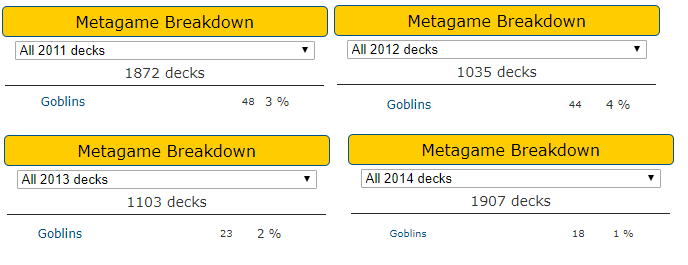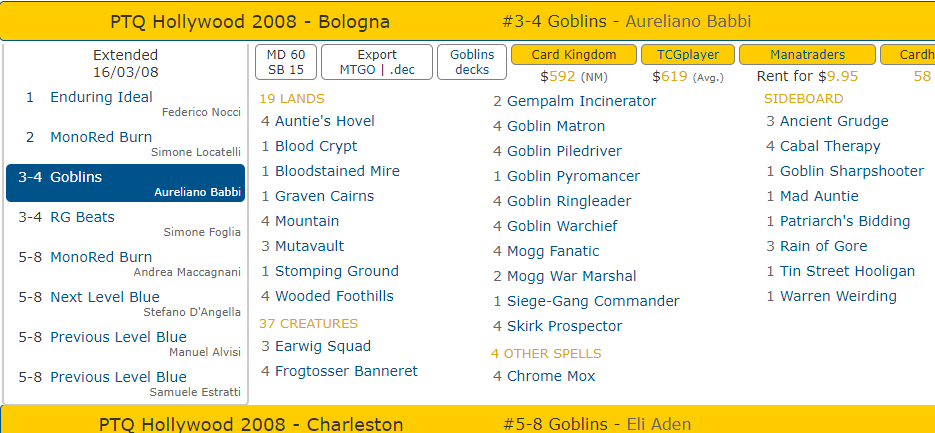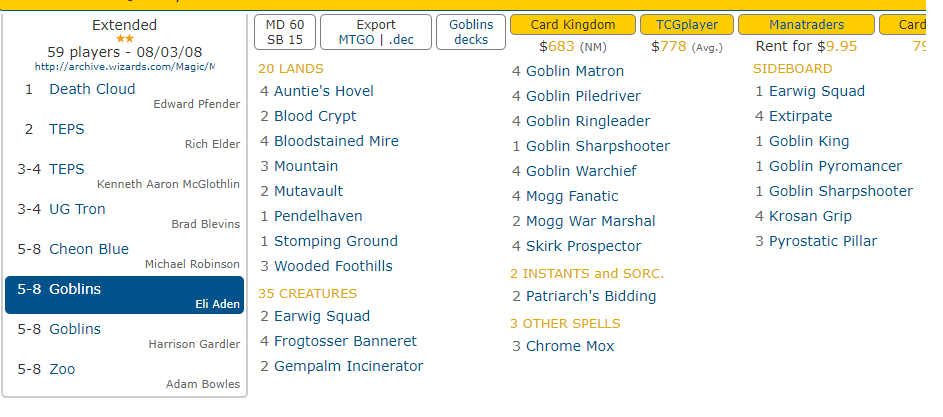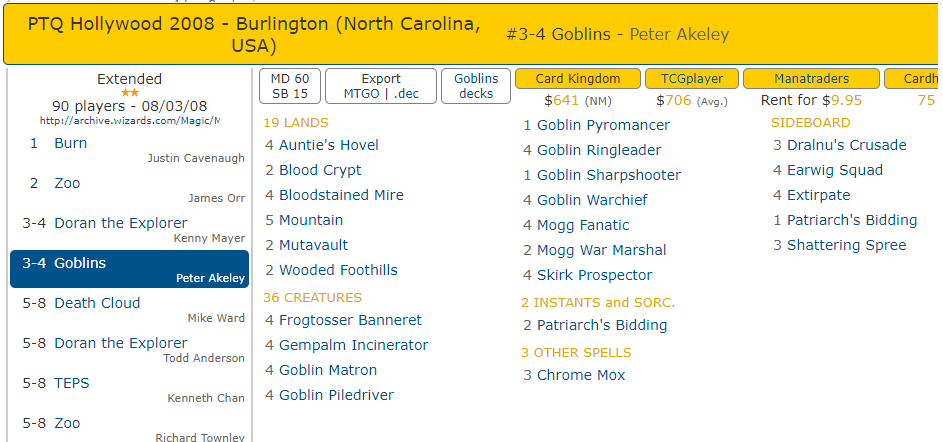With the recently spoiled Goblin Ringleader on the horizon (or perhaps, just beyond the horizon), there has been a lot of talk about playing Goblins in Modern and rightly so. The historic goblin powerhouses are finally back together again in a new format, bringing new hope to an archetype that has been competitively dead since 2013 or so. With many people sharing list after list on Reddit and various Discord channels, it would be easy to think that Goblins is primed for some modicum of success, but many of these lists are flawed, structurally or contextually because they are emulations taken out of context. Let’s have a look at the most well known Goblin deck in 2019.




Click Image to Enlarge
The strategies the Legacy deck utilizes are threefold. First, use Aether Vial and Goblin Lackey to cheat on mana. Second, use Wasteland and Rishadan to deny your opponents mana. These two strategies work hand in hand to create a large mana advantage over your opponent. While that statement is not mind blowing in any sense, it is appropriate to draw attention to the fact that Wasteland is effectively -1 mana for both players and Goblin Lackey is effectively +1-4 mana for the Goblins player, with Aether Vial being similar but slower. Compounding this advantage over turns is how Legacy Goblins wins games. The tertiary strategy is using Goblin Matron to find specific answers to specific scenarios, such as Stingscourger bouncing a Show and Tell fatty or Chainwhirler to kill DNT creatures. You can see the most favorable field or the field in which most people played Legacy Goblins was in 2012.

This approach used to work in Legacy. My apologies to the diehards, but it stopped working five years ago and never really started working again. There are a lot of reasons why the Legacy deck faded into obscurity, but I am not going to go into them in this post. Many people are using these Legacy lists as their blueprint for their Modern Goblins deck.
However, there is another, lesser known format that Goblins was a staple in. That format was Extended. For a brief history of the Extended format, you can read a little about it here: https://mtg.gamepedia.com/Extended. What you need to know about this format is that in 2008, it included seven years worth of sets, Invasion through Lorwyn, and that Goblin Lackey and Aether Vial were banned. These decks operated much differently to their Legacy counterparts. Where Legacy Goblins are trying to play a slow game built on mana advantage over turns and a toolbox of select one ofs to answer certain decks, Extended Goblins eschewed almost all of that in favor of a more streamlined aggressive engine built upon the synergy of Matron/Ringleader/Warchief/Piledriver. Bear in mind that being aggressive does not preclude a deck from being a midrange deck. Consider the difference between a Jund deck and Junk a deck. Both midrange, but one is more aggressive. Extended Goblins is an aggressive synergistic midrange deck. Think of it like a big Affinity deck, if you will. The premier Extended Goblin deck was Goblin Bidding. A deck based around the core goblins and Patriarch’s Bidding as a curve topping game ending spell.




Click Image to Enlarge
These decks are a lot more sparse with their tutor targets. There is Siege Gang Commander and Goblin Sharpshooter to break board stalls in conjunction with Prospector to shoot face. There is Goblin Pyromancer to alpha strike. Very few other tutor targets were utilized. The ones that were played were meant to be cards that end the game. Proactive tutor targets, rather than the reactive tutor targets from earlier. Like their Legacy counterparts these decks are also utilizing a strategy that cheats on mana, but in a different way. Without Wasteland, Rishadan Port, and Goblin Lackey to create mana advantage early, they instead turned to cards like Skirk Prospector, Frogtosser Banneret, and Chrome Mox alongside the full set of Goblin Warchiefs to supplement a more beat down orientated plan, fueled by Goblin Piledrivers and Goblin Pyromancer, instead of a relying on turns per game to create more free mana. Let me go into detail.
We discussed earlier how the Legacy creates a mana advantage over the course of time. You can almost always calculate how much mana you’ve gained at the end of each turn. For a simple example: using Rishadan Port to tap one of your opponents lands and then Vialing in a three mana Goblin on their end step is how much mana gained? Assume your opponent made their land drop. You denied your opponent one mana, leaving them at -1, you spent 3 mana activate Port and cast vial previously, and you got a free three drop. -3 + 3 = 0. You are net zero mana, and your opponent is net -1 mana, therefore you have gained 1 mana over your opponent. The Legacy deck compounds these advantages over turns spent playing the game to win.
If you think of this as mana gained per turn, the more turns there are in a game the more likely you are to win. This is important.
The Extended deck creates mana in a much different fashion. I want to focus specifically on Frogtosser Banneret, because the other ramp effects they utilized are easy to understand, those being Skirk Prospector and Chrome Mox. Pay a card, get a mana. Simple. Frogtosser, on the other, is a little more involved. We are going to assume that you are allowed to untap with Frogtosser and that you make your land drop on turn three. At this point, Frogtosser has gained you mana based upon what cards you have in hand. If you have three two drops, you have gained +3 mana. If you have a two drop and a three drop, you have gained +2 mana, and so on. This type of mana gain allows much more explosive plays than it’s Legacy counterpart, and it aims to leverage these bursts of mana to create heavily favorable or game ending board states.
With the exclusion of Goblin Lackey, the Legacy deck has a much more difficult time casting multiple spells per turn before turn 4 or 5, because it either interrupts the activation of Rishadan Port and Wasteland or Aether Vial has not ticked up enough yet. This is also important.
So while the two decks look similar, you can see how they function very differently at a structural level. Legacy benefits from there being more turns in a game; Extended benefits from there being less turns in a game. How does that effect Goblin deck building decisions in Modern? Well, you tell me.

Now let’s talk about context. Everything in MTG is contextual. Is a strategy good? Depends on context. Is a card good? Depends on context. Is a deck good? Depends on context. At the time Goblins was at it’s peak, in both formats, 2008 and 2012 respectively, they looked like this.

In terms of archetypes, the two formats are quite similar, with Goblins having a similar level of success in each format. Because of this, it is reasonable to think that the shared strategy generating free mana is the strongest strategy available to Goblins.
The chief differences are between formats are: no access to Wasteland, Rishadan Port, Goblin Lackey, or Aether Vial. Therefore, denying mana to the opponent is not a viable strategy. In place of this strategy, Goblins were more focused on winning through attacking and game ending spells, like Patriarch’s Bidding or Goblin Pyromancer. Since they couldn’t play slow, they chose to play fast.
How does all of this affect Modern Goblins in 2019? Modern is something of a mixed bag. While Modern has access to Aether Vial and a worse version of Goblin Lackey (Warren Instigator), it does not have access to mana denial. While Modern has access to a lot of strong toolbox targets, Modern is faster than Legacy. Everyone knows the recipe for success in Modern at this point –
Be fast. Be proactive.
Great historical context and insight! I’ve been trying to brew lots of goblin lists lately and there are a lot of choices on how the deck should function, especially with regards to whether to use cost reduction or warren instigator.
LikeLiked by 1 person